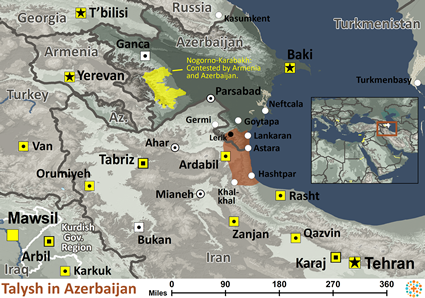The Talysh peoples (Harzani, Kajali, Karingani, Takistani, Talysh) inhabit the northwestern regions of Iran. One group can be found in southeastern Azerbaijan. They occupy a land of sharp contrasts, ranging from the high, forested Talysh Mountains to the subtropical coastal land along the Caspian Sea. They refer to themselves as the Talushon and speak an Indo-Iranian language that is also called Talysh. Although all of the Talysh groups speak their native language, most are also fluent in Azerbaijani, and some speak Russian or Farsi.
The Talysh lived in the southwest Caspian Sea region for thousands of years. They came under Turkish influence during the Middle Ages, but established their own independent khanate, or kingdom, in the 1600s.
In the early 1800s, the Talysh of present-day Azerbaijan fell under Russian control, which continued until 1991 when Azerbaijan broke away from the crumbling Soviet Union. Those in Iran are influenced by the culturally near Iranians. Today, the Talysh face the same dilemma as many other Central Asian peoples as they attempt to decide whether to follow the Islamic traditions or embrace Western culture and technology. The Talysh people in Azerbaijan have been influenced in recent decades by the Russians.
The lifestyles of the five Talysh subgroups vary greatly due to the differences in their environments. However, regardless of the region in which they live, the majority of Talysh are farmers. In some areas, rice is the primary crop; in others, they grow wheat and barley. Those in the lowlands near the Caspian Sea raise tea, citrus fruits, pumpkins, melons, garlic, onions, peas and grapes.
Not all of the Talysh are farmers. Some are skilled craftsmen. Their primary handicrafts include silk, rugs and felt. Some work with tin, make shoes or design jewelry.
The Talysh live in various styles of houses, depending on the region in which they are located. Those in the mountainous areas typically live in flat-roofed homes built of uncut stone. Those in the coastal zone live in clay houses that have roofs made of reeds or sedge (grass-like plants with solid stems). The homes usually have high doors reaching to the ceiling since there is no opening in the roof to allow smoke from the cooking fires to escape.
Talysh women once wore traditional Muslim clothing, which consisted of veils over their faces and long robes that completely covered their bodies. Today, many Talysh women, especially those in Azerbaijan, have abandoned the customary outfit and wear Western-style clothing.
Although Islamic law permits men to have as many as four wives, most Talysh men take only one wife. The groom's family is required to pay a bride-price, or kebin, which consists of money and items such as carpets or utensils. To avoid paying the kebin, a young man will sometimes "kidnap" the prospective bride, taking her as his wife.
The Talysh are Shia Muslims. Shia practices tend toward the ecstatic. They affirm human free will, and they differ with the Sunni Muslims in matters of law and ceremony. Unlike the Sunnis, Shias believe that Mohammad's successor should be someone in his bloodline, namely Ali. Because some of their leaders have faced violent, martyr's death, Shias understand that a righteous man can be killed by the unrighteous. For this reason, Christ's death on a Roman cross isn't as foreign to them as it is to Sunnis.
To live a righteous life, you must utter the Shahada (a statement of faith), pray five times a day facing Mecca, fast from sunup to sundown during the month of Ramadan, give alms to the poor, and make a pilgrimage to Mecca if you have the means. They gather for corporate prayer on Friday afternoons at a mosque, their place of worship.
Although the Talysh are professing Muslims, some remnants of their pre-Islamic religion remain. For example, they have a great reverence for trees and groves, and trees form some of their most sacred sites. They also believe in the presence of both good and evil spirits, with the most dangerous spirit being Alazhan, the "Red Woman." Alazhan is believed to attack women during childbirth, as well as newborn babies.
There are few, if any, Talysh people who have bowed the knee to Jesus Christ.
Pray for Talysh people to have the spiritual hunger it takes to embrace Christ no matter what the cost.
Pray that the Holy Spirit will feed spiritual hunger by giving Talysh family leaders dreams of the holy and risen Christ.
Pray that churches that plant more churches will emerge among the Talysh people in Iran and Azerbaijan.
Scripture Prayers for the Talysh in Azerbaijan.
https://en.wikipedia.org/wiki/Talysh_people
https://timelessmyths.com/stories/talysh
| Profile Source: Joshua Project |

























